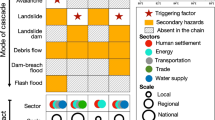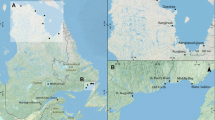Abstract
Slushflows are natural hazards that pose considerable danger to communities across the globe. These events are characterized by the rapid mass movement of water-inundated snow downslope, and they cause economic damage as well as fatalities in many different climates and regions. As the global climate changes and human populations and industries potentially expand to higher latitudes, it will be important to fully understand the slushflow hazard since an anticipated increase in the frequency of rain-on-snow events and an earlier spring thaw would likely increase the probability of slushflows. This article: (1) summarizes the factors that favor the development of slushflows; (2) discusses the hazard management implications of slushflows; (3) examines the policies employed to prevent and mitigate slushflow damage; and (4) sets out the need for modifications in hazard management systems. Conclusions drawn hope to address future research needs in an effort to create policies that better suit the needs of at-risk communities.


Similar content being viewed by others
References
Aguirre BE (no date) Planning, warning, evacuation, and search and rescue: a review of the social science research literature. Department of Sociology, College Station, Texas A & M University
Aguirre BE, Wenger D, Vigo G (1998) A test of the emergent norm theory of collective behavior. Sociol Forum 13(2):301–320
Burby RJ, Wagner F (1996) Protecting tourists from death and injury in coastal storms. Disasters 20:49–60
Burton I, Kates RW, White BF (1993) The environment as hazard, 2nd edn. Guilford Press, New York, p 290
Carey M, Huggel C, Bury J, Portocarrero C, Haeberli W (2012) An integrated socio-environmental framework for glacier hazard management and climate change adaptation: lessons from Lake 513, Cordillera Blanca, Peru. Clim Change 112(3–4):733–767
Clow DW (2010) Changes in the timing of snowmelt and streamflow in Colorado: a response to recent warming. J Clim 23:2293–2306
Cutter SL (1996) Vulnerability to environmental hazards. Prog Hum Geogr 20:529–539
Cutter SL, Finch C (2008) Temporal and spatial changes in social vulnerability to natural hazards. Proc Natl Acad Sci USA 105(7):2301–2306
Cutter SL, Barnes L, Berry M, Burton C, Evans E, Tate E, Webb J (2008) A place-based model for understanding community resilience to natural disasters. Glob Environ Change 18:598–606
Daines GE (1991) Planning, training, and exercising. In: Drabek TE, Hoetmer GJ (eds) Emergency management: principles and practice for local government. ICMA, Washington, pp 161–200
Dow K, Cutter SL (1998) Crying wolf: repeat responses to hurricane evacuation orders. Coast Manag 26:237–252
Drabek TE (1991) Microcomputers in emergency management. Monograph No. 51. Program on environment and behavior. Institute of Behavioral Science. University of Colorado
Dynes RR, Quarantelli EL (1973) The family and community context of individual reactions to disaster. Disaster Research Center, University of Delaware, Preliminary Paper #10
Eckerstorfer M, Christiansen HH (2012) Meteorology, topography and snowpack conditions causing two extreme mid-winter slush and wet slab avalanche periods in high Arctic maritime Svalbard. Permafr Periglac Process 23(1):15–25
Eitzinger C, Wiedemann P (2007) Risk perceptions in the alpine tourist destination Tyrol—an exploratory analysis of residents’ views. Tour Manag 28:911–916
Enarson E, Scanlon J (1999) Gender patterns in flood evacuation: a case study in Canada’s Red River Valley. Appl Behav Sci Rev 7:103–124
FEMA (2010) Comprehensive preparedness guide (CPG) 101.Version 2.0
FEMA (2011) Emergency planning. Independent study course 235b. Federal Emergency Management Agency, Washington
Fischer H (1998) Response to disaster: fact versus fiction and its perpetuation: the sociology of disaster. University Presses of America, Lanham
Fischhoff B, Slovic P, Lichtenstein S, Read S, Combs B (1978) How safe is safe enough? A psychometric study of attitudes towards technological risks and benefits. Policy Sci 9:127–152
Fuchs S, Thoeni M, McAlpin MC, Gruber U, Bründl M (2007) Avalanche hazard mitigation strategies assessed by cost effectiveness analyses and cost benefit analyses—evidence from Davos, Switzerland. Nat Hazards 41(1):113–129
Galea ER (2002) Simulating evacuation and circulation in planes, trains, buildings and ships using the EXODUS software. In: Schreckenberg M, Sharma SD (eds) Pedestrian and evacuation dynamics. Springer, New York, pp 203–225
Gladwin H, Peacock WG (1997) Warning and evacuation: a night for hard houses. In: Peacock WG, Morrow BH, Gladwin H (eds) Hurricane Andrew: ethnicity, gender, and the sociology of disasters. International Hurricane Center, Miami, pp 52–74
Godschalk DR (1991) Disaster mitigation and hazard management. In: Hoetmer GJ, Drabek TE (eds) Emergency management: principles and practice for local government. International City Management Association, Washington, pp 131–160
Hestnes E, Bakkehoi S (2004) Slushflow hazard prediction and warning. Ann Glaciol 38:45–51
Hestnes E, Bakkehoi S, Sandersen F, Anderson L (1994) Weather and snowpack conditions essential to slushflow release and downslope propagation. In: Proceedings of the International Snow Science Workshop, Snowbird, Utah, USA, pp 40–57
Hewitt K and Burton I (1971) The hazardousness of a place: a regional ecology of damaging events. Department of Geography Research Publication 6, University of Toronto, Toronto, Canada
Hill AA, Cutter SL (2002) Methods for determining disaster proneness. In: Cutter SL (ed) American hazardscapes: the regionalization of hazards and disasters. Joseph Henry Press, Washington, pp 13–16
Holub M, Fuchs S (2009) Mitigating mountain hazards in Austria—legislation, risk transfer, and awareness building. Nat Hazard Earth Syst 9(2):523–537
Holub M, Suda J, Fuchs S (2012) Mountain hazards: reducing vulnerability by adapted building design. Environ Earth Sci 66(7):1853–1870
Hürlimann M, Copons R, Altimir J (2006) Detailed debris flow hazard assessment in Andorra: a multidisciplinary approach. Geomorphology 78(3–4):359–372
Jaedicke C, Kern M, Gauer P, Baillifard M, Platzer K (2008) Chute experiments on slushflow dynamics. Cold Reg Sci Technol 51(2–3):156–167
Jones JAA (1999) Climate change and sustainable water resources: placing the threat of global warming in perspective. Hydrol Sci J 44:541–557
Keiler M, Kellerer-Pirklbauer A, Otto J-C (2012) Concepts and implications of environmental change and human impact: studies from Austrian geomorphological research. Geogr Ann A 94(1):1–5
Kendra J, Rozdilsky J, McEntire DA (2008) Evacuating large urban areas: Challenges for emergency management policies and concepts. J Homel Secur Emerg Manag 5: Article 32
Larocque SJ, Hetu B, Filion L (2001) Geomorphic and dendroecological impacts of slushflows in central Gaspe Peninsula (Quebec, Canada). Geogr Ann A 83(4):191–201
Leiter A (2011) The sense of snow—individuals’ perception of fatal avalanche events. J Environ Psychol 31(4):361–372
Levia DF, Leathers DJ (2011) Rain-induced snowmelt. In: Singh VP, Singh P, Haritashya UK (eds) Encyclopedia of snow, ice and glaciers. Springer, Heidelberg, pp 915–917
Lima ML (2004) On the influence of risk perception on mental health: living near an incinerator. J Environ Psychol 24:71–84
Lindell MK, Perry RW (2012) The protective action decision model: theoretical modifications and additional evidence. Risk Anal 32:616–632
Mileti D (1999) Disasters by design: a reassessment of natural hazards in the United States. Joseph Henry Press, Washington
Mileti DS, Sotensen JH (1988) Planning and implementing warning systems. In: Lystad M (ed) Mental health response to mass emergencies. Brunner/Mazel, New York, pp 321–345
Mitchell JK (1990) Human dimensions of environmental hazards: complexity, disparity, and the search for guidance. In: Kirby A (ed) Nothing to fear: risks and hazards in American society. University of Arizona Press, Tucson, pp 131–178
Mitchell JK (1996) Improving community responses to industrial disasters. In: Mitchell JK (ed) The long road to recovery: community responses to industrial disasters. United Nations University Press, New York, pp 10–40
Mitchell JK (2006) The primacy of partnership: scoping a new national disaster recovery policy. Ann Am Acad Polit Soc Sci 604:228–255
Nyberg R, Rapp A (1998) Extreme erosional events and natural hazards in the Scandinavian mountains. Ambio 27(4):292–299
Onesti LJ, Hestnes E (1989) Slush-flow questionnaire. Ann Glaciol 13:226–230
Parker DJ, Handmer JW (1998) The role of unofficial flood warning systems. J Conting Crisis Manag 6:45–60
Rapp A (1995) Case studies of geoprocesses and environmental change in mountains of northern Sweden. Geogr Ann A 77(4):189–198
Rodríguez H, Wachtendorf T, Kendra J, Trainor J (2006) A snapshot of the 2004 Indian Ocean tsunami: societal impacts and consequences. Disaster Prev Manag 15:163–177
Scherer D, Gude M, Gempeler M, Parlow E (1998) Atmospheric and hydrological boundary conditions for slushflow initiation due to snowmelt. Ann Glaciol 26:377–380
Slovic P (1987) Perception of risk. Science 236(4799):280–285
Sorensen J (2002) Risk communication and disaster warning: lessons for counter-terrorism. national academy of sciences forum: countering terrorism: lessons learned from natural and technological. Disasters 28:2002
Stimberis J, Rubin CM (2011) Glide avalanche response to an extreme rain-on-snow event, Snoqualmie Pass, Washington, USA. J Glaciol 57:468–474
Trainor J, Murray-Tuite P, Edara P, Fallah-Fini S, Triantis K (2013) Interdisciplinary approach to evacuation modeling. Nat Hazards Rev 14:151–162
Turner BL, Kasperson RE, Matson PA, McCarthy JJ, Corell RW, Christensen L, Eckley N, Kasperson JX, Luers A, Martello ML, Polsky C, Pulsipher A, Schiller A (2003a) A framework for vulnerability analysis in sustainability science. Proc Natl Acad Sci USA 100(14):8074–8079
Turner BL, Matson PA, McCarthy JJ, Corell RW, Chistensen EL, Eckley N, Hovelsrud-Broda GK, Kasperson JX, Kasperson RE, Luers A, Martello ML, Mathiesen S, Naylor R, Polsky C, Pulsipher A, Schiller A, Selin H, Tyler N (2003b) Illustrating the coupled human-environment system for vulnerability analysis: three case studies. Proc Natl Acad Sci USA 100(14):8080–8085
Varnes D (1984) Landslide hazard zonation: a review of principles and practice. United Nations Educational, Scientific and Cultural Organization, Paris
Wenger DE, Weller JM (1973) Disaster subcultures: the cultural residues of community disasters. University of Delaware, Disaster Research Center. Preliminary Paper # 9
White GF (1973) Natural hazards research. In: Chorley RJ (ed) Directions in geography. Methuen, London, pp 193–216
Wood MM, Mileti DS, Kano M, Kelley MM, Regan R, Bourque LB (2012) Communicating actionable risk for terrorism and other hazards. Risk Anal 32:601–615
Author information
Authors and Affiliations
Corresponding author
Rights and permissions
About this article
Cite this article
Relf, G., Kendra, J.M., Schwartz, R.M. et al. Slushflows: science and planning considerations for an expanding hazard. Nat Hazards 78, 333–354 (2015). https://doi.org/10.1007/s11069-015-1716-8
Received:
Accepted:
Published:
Issue Date:
DOI: https://doi.org/10.1007/s11069-015-1716-8




